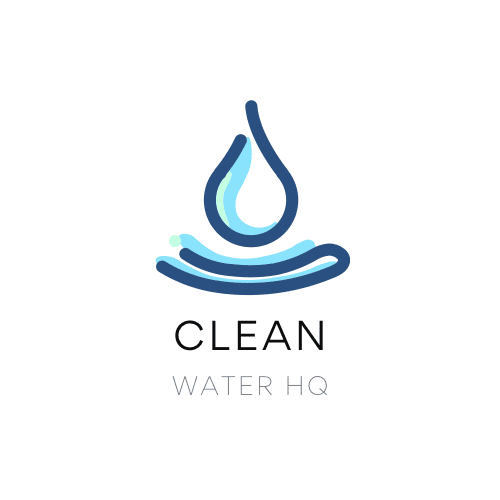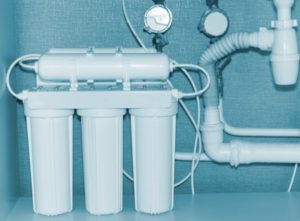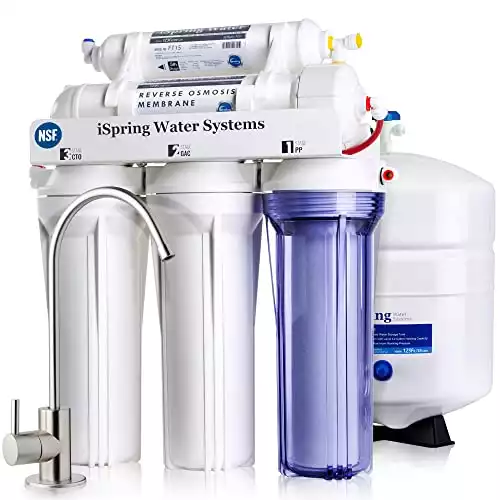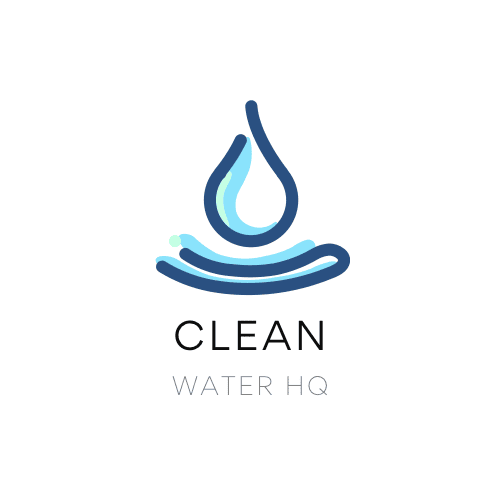iSpring’s RCC7 is exceptionally affordable for a reverse osmosis filter system. As a tradeoff, it produces a lot of waste water and has questionably reliable plastic components.
What We Like
- Very affordable for a reverse osmosis system
- Innovative clear filter design lets you know when it’s time to replace filters
- Responsive US-based customer service
What We Don’t Like
- Large waste water production
- Plastic components have long-term reliability issues
- Extended warranties are quite expensive
If your water is seriously cloudy and filled with hard minerals, a reverse osmosis (RO) system is the best way to go. But the sticker shock associated with most RO filters might keep you from buying one. The iSpring RCC7 reverse osmosis filtration system is one of the very few RO systems that’s affordable enough for most homes.
In our review of iSpring’s RCC7, we’ll be taking a thorough look at every aspect of this 3-stage reverse osmosis system. We’ll give you a clear verdict on who it’s right for — and who might want to upgrade to a different system instead.
Components
In the RCC7’s box, you’ll find:
- Filter housings
- Filter cartridges
- Fittings
- Tubing
- Faucet
- Mounting bracket
- Storage tank
This is about the most parts you’ll find in any under sink system. If you’re looking for an easy DIY project, reverse osmosis systems aren’t it. But if you’re willing to put in a few hours of research and installation, it will provide an incredibly thorough filtering capacity. Thankfully, iSpring’s customer support is just a phone call away for immediate help with anything that comes up.
How It Works
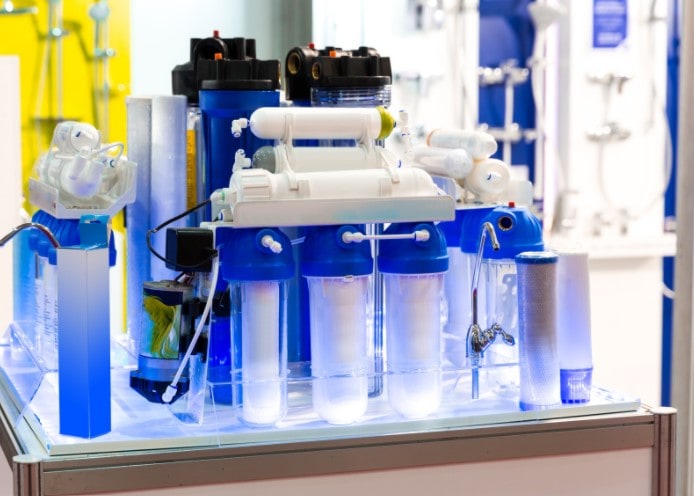
The iSpring RCC7 is a 5-stage reverse osmosis filter. Let’s unpack each filtering stage in more detail.
Stage One is a polypropylene sediment filter. It catches the largest particles of dirt, rust, and sand. This helps extend the life of each subsequent filter.
Stage Two is the first of three carbon filters. It helps to remove chlorine, lead, mercury, iron, and hydrogen sulfide.
Stage Three is a solid block carbon filter. It removes chlorine and chloramine that could otherwise damage the further filtering layers.
Stage Four is the main attraction, a reverse osmosis (RO) membrane. It removes particles down to 0.0001 microns, making for extremely purified water.
Stage Five is a granular activated carbon filter. It gives a final polish to the water, restoring some of the minerals that have been lost. This helps the iSpring RCC7 make great-tasting water.
Water flows from your cold water line through these filtration stages. Then it’s stored in an auxiliary tank. This is connected to a dedicated faucet where the purified water is dispensed.
Performance
The iSpring RCC7 has just one, very important certification.
NSF/ANSI Certification 58 was developed explicitly for reverse osmosis water filter systems. It covers seven aspects of the filter system:
- Safety of materials in contact with drinking water
- Structural integrity
- TDS (total dissolved solids) reduction performance
- Efficiency rating
- Recovery rating
- Contaminant reduction performance
- Information for the end user
This is all to say: The iSpring is fully certified as an effective RO system. It is capable of removing just about everything from a municipal water source.
This performance comes at a cost, though. The RCC7 produces about 3 gallons of wastewater for every 1 gallon of freshwater. So, depending on how much you use it, this filtration method can lead to inflated monthly water bills.
Flow Rate
Any reverse osmosis water filtration system will impact your water pressure and flow rate. The iSpring RCC7 is no exception. If your water pressure is below 40 psi, you’ll need to install a booster. And if it’s above 80 psi, you’ll need to install a regulator.
Among RO systems though, the RCC7 has a good rating for its daily water production. It will make at least 75 gallons of purified water per day. This is a larger capacity than most RO systems offer. And it’s more than enough for a family of four or more.
Flow rates average .5 gallons per minute under good conditions. This means you can fill a cup of water in 10 seconds or less.
Installation
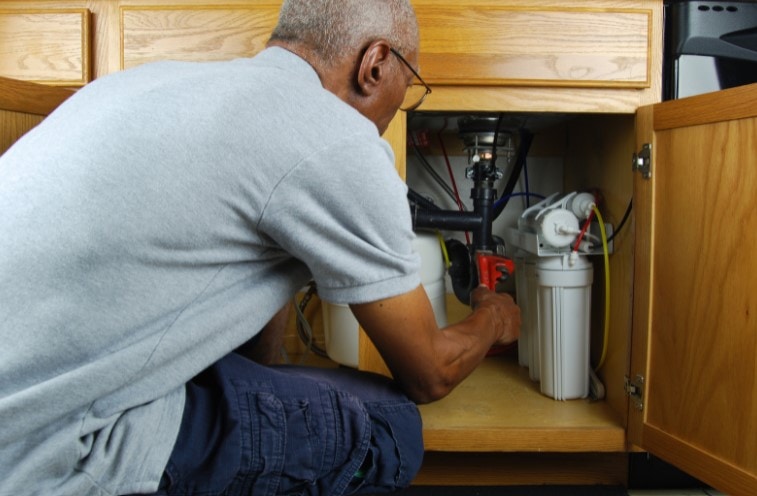
Though it’s designed for DIY installation, the iSpring RCC7 still takes a fair bit of work to install. Everything you need is included in the box. And the directions are clear and well written. But it’s just the nature of RO systems, with their many parts, that they’re more difficult to install than other under sink filters.
iSpring’s customer service is top-notch. If you have any troubles while you’re preparing to install the RCC7, give them a call. Their support hotline is based out of Georgia, and very easy to work with.
For a clearer picture of what’s involved with the installation, watch this video:
Filter Replacement
Filter replacements for the RCC7 are very reasonably priced. And you only have to replace them once per year. They’re available for just under $46 via iSpring’s website.
When it’s time to replace the filters, it’s as easy as screwing off the old ones and putting on new ones. It takes no time at all. And since the first filter stage is in a clear housing, you’ll be able to tell at a glance when it’s time for new ones.
Build Quality
For all of its other benefits, the build quality of the RCC7 is a tradeoff worth mentioning.
Most of this system’s parts are made of plastic. And judging from the many reviews which mention faults in the plastic after a few years, this calls into question its reliability.
Will everyone experience problems with the iSpring’s plastic components? No. But if you’re looking for an RO system that’s made for the long haul, you’ll need to invest substantially more money in a different system.
As it stands, this makes the RCC7 a great choice for temporary solutions. If you’re renting a home or apartment, it’s ideal. But if you’re trying to ensure filtered water for 5+ years, you may be better off with a different system that uses more durable parts.
Warranty & Support
The RCC7 is backed by a 1-year warranty with a money-back guarantee. If for any reason you’re not satisfied with it in the first 12 months, you can return it for a full refund.
The Georgia-based customer support line offers expert advice to help with installation and troubleshooting. They’re very helpful and easy to talk to.
Extended warranties are available, but they’re as expensive or more as the system itself. A 3-year warranty will cost $132, while a 5-year costs $220 and a 10-year costs $330.
Recap
The iSpring RCC7 reverse osmosis water filter system is without a doubt one of the most affordable RO systems out there. As a tradeoff, it produces a lot of waste water and is made with plastic components. If you’re looking for a water filter that will last about 3 years, it’s a bargain. But if you want something for the long haul, look elsewhere and invest more.
Frequently Asked Questions
What does the iSpring RCC7 cost per gallon?
Filter replacements cost $46 and last for 12 months. This means they can filter about 2000 gallons, for a cost of 2.3 cents per gallon.
What contaminants does this water filter remove?
The iSpring RCC7 removes up to 99% of over 1, 000 contaminants, including lead (removes up to 98% of lead), chlorine, fluoride, arsenic, asbestos, calcium, sodium, and more.
How long does this water filter last?
Each set of iSpring RCC7 filter cartridges lasts for 1 year.
